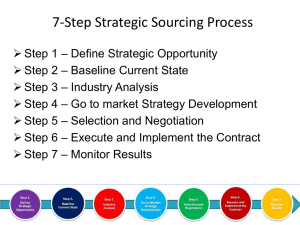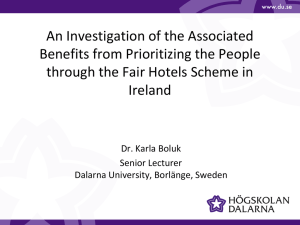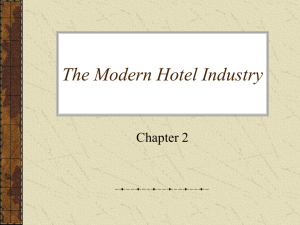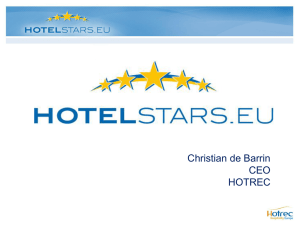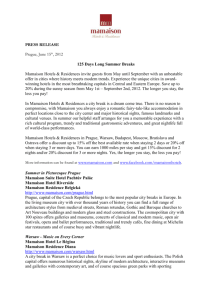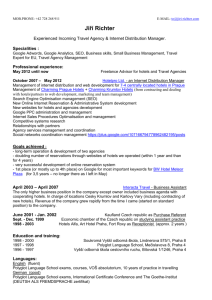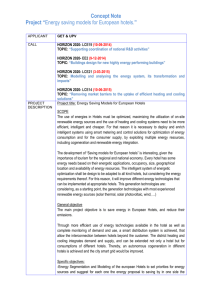Presentation 4
advertisement
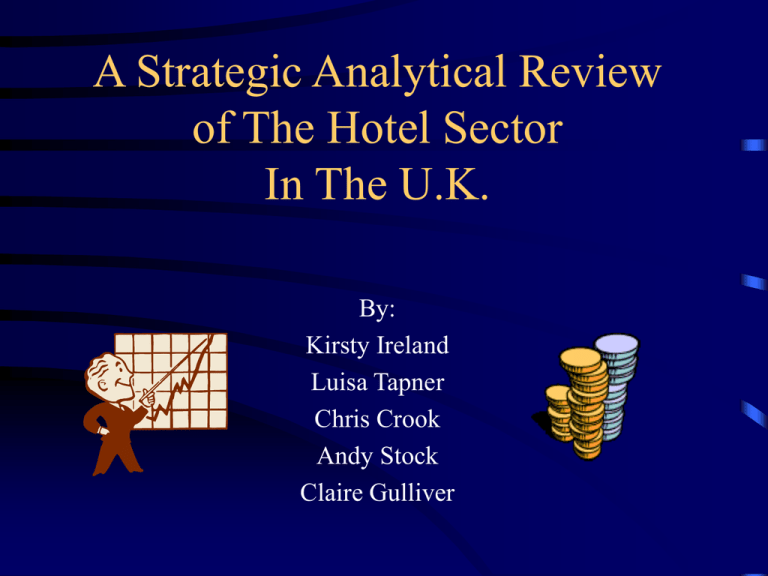
A Strategic Analytical Review of The Hotel Sector In The U.K. By: Kirsty Ireland Luisa Tapner Chris Crook Andy Stock Claire Gulliver Contents • • • • • • • • • • Introduction Key Markets and Trends D.E.E.P.L.I.S.T Factors (Macro-Economy) Porters 5 Forces Models B.C.G Matrix Sector Life Cycle Stakeholder Map S.W.O.T (The sector as a whole) S.W.O.T (Recommended area within the sector) Predicting the future of the sector Introduction A definition of the hotel sector The hotel sector is a range of commercially rated businesses which provide accommodation, breakfast and at least one other main meal service to residents and non-residents. Additional facilities sometimes include room service, a gym, a licensed bar, and a swimming pool. Due to the diversity and complexity of the hotel sector, we have chosen to look at the U.K and divide the sector using the AA star classification system (1*- 5*) Key Markets • • • • • • Corporate Leisure Conference Weddings Private Parties Masonic Lodges All of which exist: • Nationally and Internationally • On a budget to deluxe level Trends – Pre September 11th • The U.K’s economy has shown steady growth since 1995. Increase in the value of the pound meant the U.K was seen as an expensive destination. • Higher disposable income and cheaper flights/destinations means that much of the U.K population is holidaying abroad. • The number of leisure guests visiting the U.K (Long stay or short break) are declining. • High proportion of investment in the 3 and 4 Star markets. • Corporate clients remain the hotels’ main revenue earner. • Conference business is slowing down due to advances in technology. • Rise in national and international hotel chains • Lack of adequately trained/qualified staff (Skills shortages) Trends – Post September 11th • Fewer people are travelling (staying closer to home) • Consumer confidence is getting weaker • Job cuts have already been made by many companies • Declining overall investment • Manufacturing is in recession whilst services are holding up • Only a 1 in 3 chance of U.K going into full recession • Airlines have slashed routes and staffing • Major decline in RevPAR in most large cities D.E.E.P.L.I.S.T Demographic • U.K population is stable but an ageing “grey” population is emerging. Ecological • Foot and Mouth • Increased Environmental Awareness Economic Political • • • • • War • Terrorism Possible Recession Foot and Mouth, B.S.E Terrorism and War Euro D.E.E.P.L.I.S.T Cont. Legal Sociological • • • • • • Disability Discrimination Act Monopoly and Mergers Commission Minimum Wage Euro Ethnic Issues Personal Disposable Income Technological Informational • Increased availability of worldwide information eg World Wide Web • Internet Awareness • Transport Infrastructure • Key cards, in-house movies Porter’s 5 Forces Buyers Supplie r Very Little Supplie r Power 1 Star Hotels Cost Orientate d “Cheapes t Option” Supplie r Some Supplie r Power Buyers 2/3 Star Hotels Selectiveness Location Incentives for business markets Supplier Luxury items Brand awarenes s Quality Food Supplier Buyers 4/5 Star Hotels Affluent Higher PDI Loss of Busines s trade BCG Matrix High Market Share High Low ??? 4* 2* Growth 5* 3* 1* Low Sector Life Cycle Introduction Growth 4* Maturity Decline 3* 5* 2* RevPAR 1* N.B – Only a static view of which phase each segment is currently in Stakeholder Map For Investment In The 2 Star Hotel Sector Low Minimal Effort Low Power High • Casual Staff • Suppliers • Community Level of Interest High Keep Informed • Other Operations • Independants • Long Term Staff Keep Satisfied Key Players • Government • Customers • Chairman • Shareholders S.W.O.T For The Hotel Industry In General Strengths Weaknesses • Linked closely to the economy • There will always be a demand • Plentiful staff • Lower PDI in short term • Linked closely to the economy • Lack of trained & qualified staff • Volatility of demand Opportunities Threats • 6-12 months = good time to invest • Declining airline usage = Recapture U.K short break and longer holiday markets. • European markets instead of America • Technological Advances. • Operationally mature but investment is only really just starting to emerge. • • • • • • • • Foot and Mouth, BSE Terrorism and war High levels of competition (Nat/Int.) Established chain competition Travel to hot countries within a few hrs Increased insurance costs Cost of redundancies Main cities under threat due to terrorism S.W.O.T For The 2 Star Hotel Sector Strengths Weaknesses • Budget sector is resilient • Trained and qualified staff not needed • Less volatility due to constantly high occupancy rates • Possible bad image due to cheapness Opportunities Threats • Increased budget airline activity = • Established chain competition budget hotels used by customers/staff • Same Nat/Int. threats as previous slide • High bankruptcy rates during recession may mean cheap properties available. • Franchises eg Choice Hotels, Express • Displacement of business from B&B’s and 3* hotels • High revpar through refugees Predicting The Future of The Sector • Hot sectors will be the budget/economy resort hotels. (Indicated Growth of 52% over next 5 yrs in budget hotels) • Major cities will remain exposed due to terrorism/Int. demand. However this may be shorter lived than first imagined. In this case the hotels in major cities will be the first to bounce back after recession • RevPAR decline should start to slow down • Potential for refurbishment programmes • Recession predicted to last for between 6 -12 months • Property prices will fall over the coming year posing an excellent opportunity to invest (Especially in strong cities) Thank You For Listening To Our Presentation Any Questions?


